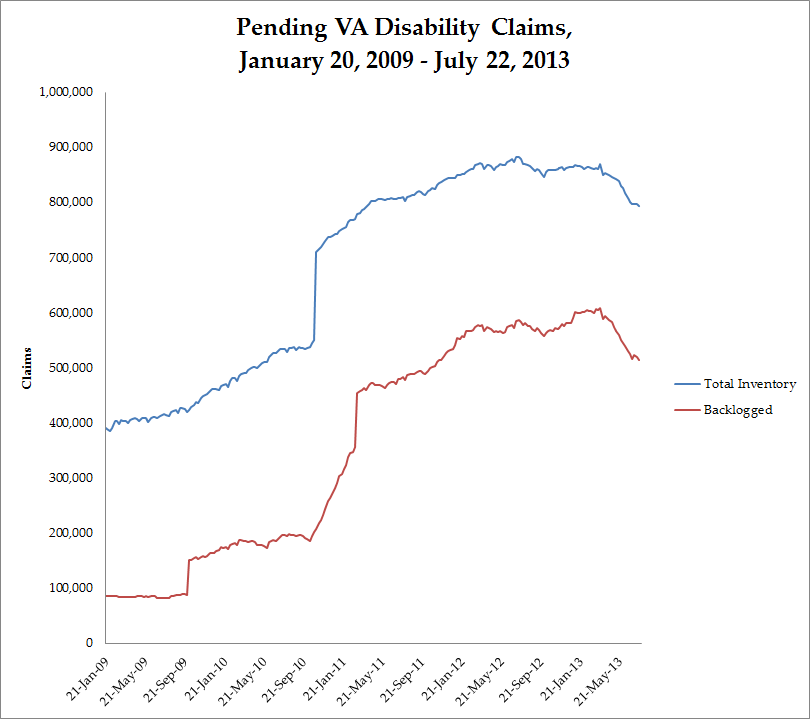In a letter to President Obama on July 19, Republican Senator John Cornyn of Texas relayed his concerns about the disability claims backlog facing the Department of Veterans Affairs. “The status quo at the VA is unacceptable,” he wrote, “and it cannot be allowed to continue.”
As with many other critics of VA—political and otherwise—Senator Cornyn’s information is considerably outdated. In reality, the VA backlog has dropped steeply—by more than 15%—since March. By arguing “the status quo is unacceptable” (and that “it cannot be allowed to continue”), Senator Cornyn and others are essentially arguing against the progress of the last four months.
Let’s take a look at the latest numbers.
As the chart makes clear, if one opposes rapid progress toward the goal, then one might, in fact, believe “the status quo is unacceptable” and must not “be allowed to continue.” Because this point is no longer in contention: the VA backlog is—and has been—headed in the right direction.
The total number of backlogged claims (those in the system longer than 125 days) has now fallen to 515,000—the lowest point since fall 2011. The total inventory of claims recently dropped below 800,000 for the first time in more than two years. It now stands at just over 793,000, down from a high of 883,000 claims one year ago.
As VA’s electronic-claims processing system is further integrated into all regional processing offices throughout 2013, the rate of decline will likely continue. There will be hiccups and uneven progress along the way, but as I wrote in June, the worst—which happened for very specific reasons—is now over.
Therefore, those wanting to assist the situation should focus on helping VA educate veterans about navigating the new claims process as it comes online.
For this reason, continued calls for commissions and “idea reports” on ending the VA backlog are unhelpful.
In fact, these demands for greater attention on the topic indicate one of two things: the first possibility is that proponents of commissions and petitions still fail to grasp that driving any substantive change within the Department literally takes years. Secretary Shinseki made this point at the Veterans of Foreign Wars annual conference on Tuesday:
We’ve said all along it would take time to solve this correctly. And we are not going to leave this for another secretary and president to wrestle with. We are on track to eliminate the backlog in 2015. We started out four years ago with a plan, and we’ve stayed with it.
If organizations and elected officials are now ignoring this fact, then they would do well to listen to Senator Bernie Sanders, I-Vt., chairman of the Senate Veterans Affairs Committee. He recently said commissions would “likely not help solve the problem” and would, in fact, “slow down the progress you’re making.”
The second possibility is that politicians and advocates—seeing the progress—are looking to quickly propose shallow solutions to the VA backlog so as to position themselves to take credit once it’s finally eliminated. Hopefully, that’s not the case.
Either way, this is indisputable: the VA backlog is falling because the department began implementing a long-term plan to end it in 2010. As VA does its part, elected leaders and veteran organizations should do theirs. And that means educating veterans about the claims process—not focusing on wasteful commissions and letters to the President.
Brandon Friedman is a vice president at FleishmanHillard in Washington, D.C. and the author of The War I Always Wanted. From 2009 to 2012, he worked at the U.S. Department of Veterans Affairs. Follow him on Twitter at @BFriedmanDC.


